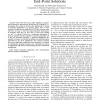Free Online Productivity Tools
i2Speak
i2Symbol
i2OCR
iTex2Img
iWeb2Print
iWeb2Shot
i2Type
iPdf2Split
iPdf2Merge
i2Bopomofo
i2Arabic
i2Style
i2Image
i2PDF
iLatex2Rtf
Sci2ools
TON
2010
2010
Upgrading mice to elephants: effects and end-point solutions
Abstract— Short TCP flows may suffer significant responsetime performance degradations during network congestion. Unfortunately, this creates an incentive for misbehavior by clients of interactive applications (e.g., gaming, telnet, web): to send “dummy” packets into the network at a TCP-fair rate even when they have no data to send, thus improving their performance in moments when they do have data to send. Even though no “law” is violated in this way, a large-scale deployment of such an approach has the potential to seriously jeopardize one of the core Internet’s principles — statistical multiplexing. We quantify, by means of analytical modeling and simulation, gains achievable by the above misbehavior. Our research indicates that easy-to-implement application-level techniques are capable of dramatically reducing incentives for conducting the above transgressions, still without compromising the idea of statistical multiplexing.
Abstract— Short TCP | Easy-to-implement Application-level Techniques | Responsetime Performance Degradations | TON 2010 |
| Added | 31 Jan 2011 |
| Updated | 31 Jan 2011 |
| Type | Journal |
| Year | 2010 |
| Where | TON |
| Authors | Amit Mondal, Aleksandar Kuzmanovic |
Comments (0)

